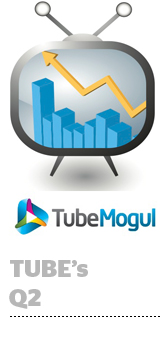 Video demand-side platform (DSP) TubeMogul, which first began trading on the NASDAQ in July, reported $28.7 million in revenue for the second quarter.
Video demand-side platform (DSP) TubeMogul, which first began trading on the NASDAQ in July, reported $28.7 million in revenue for the second quarter.
This was a 127% increase over last year, when that figure totaled $12.6 million. Total advertiser spend in Q2 was $61.1 million. Read the earnings release.
As a point of reference, video ads platform Tremor reported Q2 revenue of $43.7 million while YuMe’s was $40.4 million. TubeMogul slightly beat analyst estimates, which were in the $25 million range.
TubeMogul’s self-serve Platform Direct business generated $11.6 million in revenue for the quarter while Platform Services revenue was $17.1 million. This, too, beat some analysts’ estimates, which projected those revenue numbers to be $9 million and $16 million, respectively. Total spend for the quarter running through TubeMogul’s self-serve platform was $44 million, accounting for 72% of total spend.
Platform Direct, according to company CFO Paul Joachim, is the “growth driver” of the business, basically doubling the number of brand advertisers using the platform to 283 last quarter. Although a majority of clients are first exposed to TubeMogul through Platform Services, the company sees this as a long-term driver for its platform business when migrating them over. About 25% of its Platform Direct clients were first exposed to the company through Platform Services.
“I think it highlights the difference in our software model vs. the model of other companies that are chasing the RFP business, which is a very expensive proposition,” Brett Wilson, TubeMogul’s CEO, told AdExchanger. “We’re selling in software just one time and after that, clients consolidate their spend with us with little to no sales costs, so our model supports a lot more operating leverage.”
He reiterated this sentiment during the earnings call: “Most media is bought and sold on a manual request for proposal basis with high sales costs. We have little to no ongoing sales costs with our platform. … We are 100% advertiser-focused and have no incentives to shift client dollars to publishers.”
This “frees them up to focus on strategy instead of logistics and ad trafficking,” he added. “Through our software, advertisers can capture over 40 metrics at the site level, including viewability. … TubeMogul isn’t a black box. Advertisers know exactly what’s working, and this becomes their intellectual property.”
Wilson was adamant that “our self-serve Platform Direct is not an ad network model,” citing its BrandPoint product as a tool that enables advertisers to plan, measure and buy based on a digital GRP. The company was an originating founder of an open-source viewability standard and recently partnered exclusively with Integral Ad Science for third-party ad verification.
Among some of those advertisers are Lenovo and CPG company Mondelez International, which went “100% programmatic” with TubeMogul in the last quarter. While Joachim acknowledged that more brands are driving media technology decisions, “it doesn’t mean they’re taking the software in-house.”
He acknowledged an agency is often involved (MediaVest in Mondelez’s case) and said TubeMogul gets agencies up and running campaigns on their own after some training. “These models [agency, vendor, brand hybrid] have the least friction in the market,” he said. “Agencies have growing programmatic expertise in house.”
“We believe the company was early to get ahead of advertisers’ increased calls for transparency, and as Platform Direct becomes a larger mix of the business, gross margins should increase,” noted Dan Salmon, equity research analyst at BMO Capital Markets, in a research brief. However, market competition could strain the services and platform take rate.
With TubeMogul’s continued focus on international expansion, particularly Australia and China, software installs that allow for remote maintenance and product roll out are attractive to reduce overhead.
“It’s much easier for us to set up shop in a new market than companies that are effectively ad networks and need to hire sales people, biz dev people to aggregate inventory while we can be up and running quickly,” Wilson said. “Our last couple of client wins have been brands and agencies that are global in nature and they benefit from a software model.”













